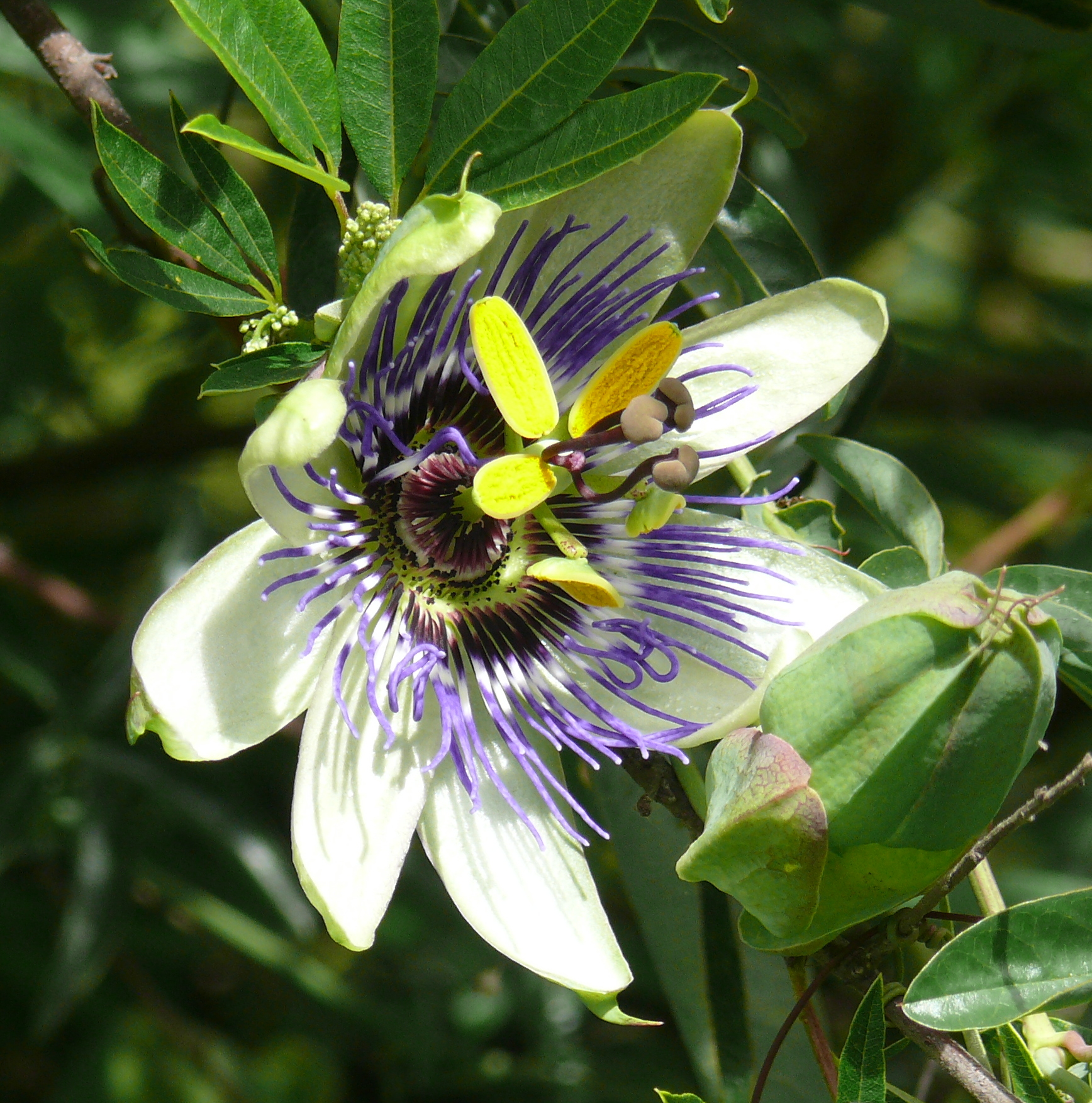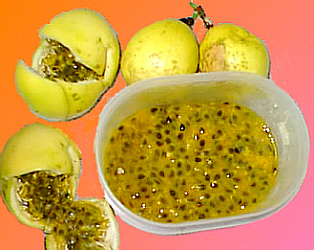The chemistry of passion fruit
Introduction
The passion fruit is a native of tropical America and was noted
by the Spanish in Brazil in the 1500's. There are more than 500
species of which at least 50 or more are edible.
The two main commercial varieties are Passiflora
edulis L. a purple fruit and P. edulis f.
flavicarpa a yellow variety.
Brazil is the largest producer of passion fruit in the world
with more than 35,000 ha under cultivation providing 485 thousand
tons of fruit. The yellow passion fruit is the most
important species cultivated in Brazil, corresponding to 95% of
the planted area.
Australia and Brazil are the largest markets for passion fruit where the
bulk is used for blending with other juices and in softdrinks.
Chemistry
Sugars
The total carbohydrate content is around 15-20 % with slight
variations between the purple and yellow varieties.
The breakdown (in percent) is given as:
| |
fructose |
glucose |
sucrose |
| purple |
33.5 |
37.1 |
29.4 |
| yellow |
29.4 |
38.1 |
32.4 |
with a trace of 7 others.
Acids
Both yellow and purple have a high acid content (pH around 3) and
the breakdown has been given as:
| meq/100g |
citric acid |
malic acid |
lactic acid |
malonic acid |
succinic acid |
ascorbic acid |
| purple |
13.1 |
3.86 |
7.49 |
4.95 |
2.42 |
0.05 |
| yellow |
55 |
10.55 |
0.58 |
0.13 |
trace |
0.06 |
The sugar/acid ratio is sometimes used as a measure of sweetness
and there is a significant difference between the purple and
yellow varieties, 5:1 compared to 3:8, so that the purple is
generally considered to be sweeter.
Pigments
In 1963, it was determined that the colour of the passion fruit
was not due to anthocyanins and only trace amounts of flavones
were found as well.
In 1972, further work identified the major carotenoid pigments
in the purple variety, which included:
- alpha-carotene
-
beta-carotene
- gamma-carotene
-
phytofluene
- beta-apo-12'-carotenal
- beta-apo-8'-carotenal
- cryptoxanthin
- auroxanthin
- mutatoxanthin
Alkaloids
In 1975, 7 alkaloids were detected and 4 were identified as
harman(e), harmol, harmin and
harmalin. Pharmacological tests
showed that the juices had slight sedative effects.
Harman(e) (CAS 486-84-0, Molform= C 12 H 10 N 2) is shown below.
Volatiles
By 1972, over 165 compounds had been detected in the volatiles of
the juice of the yellow variety. The highest quantities being
C2-C8 esters of the C2-C8 fatty acids. Other volatiles included
the degradation products of carotenoids, sulfur-containing
components and some unusual aliphatic esters.
D.J. Casimir and F.B. Whitfield in 1978 introduced the concept of the
"flavour impact value" and from the over 300 volatile flavour
components that they detected, identified 22 as having passion
fruit flavour. Using linear regression methods they were able to
reproduce the natural flavour by combining 15 of these volatiles
and calculated each chemicals contribution to the flavour
profile.
Flavour-Impact Values
| Compound |
Flavour
impact value |
Concentration
in juice (ppm) |
Contribution
to flavour
profile(%) |
6-(but-2'-enylidene)
1,5,5-trimethylcyclohex-1-ene |
79 |
1.1 |
30 |
| (Z)-hex-3-enyl butanoate |
41 |
0.8 |
11 |
| hexyl butanoate |
6.8 |
4.1 |
9 |
| ethyl (Z)-oct-4-enoate |
62 |
0.4 |
8 |
| β-ionone |
410 |
0.05 |
7 |
| edulan I |
23 |
0.8 |
6 |
| ethyl (Z)-octa-4,7-dienoate |
239 |
0.06 |
5 |
| Linalool |
30 |
0.05 |
5 |
| Ethyl hexanoate |
1.3 |
7.6 |
3 |
| heptan-2-ol |
1.7 |
5.3 |
3 |
| (Z)-hex-3-enol |
26 |
0.3 |
3 |
| S compounds |
76 |
0.1 |
3 |
| hexanol/ nonan-2-one |
1.8 |
4.0 |
3 |
| Rose oxide |
45 |
0.2 |
2 |
| methyl butanoate |
0.7 |
8.3 |
3 |
A simulated
GC of the headspace vapours of yellow passionfruit is available
as a JSmol display.
A fascinating distinction between the yellow and purple
passionfruit was found on studying the presence of chiral
compounds. For example, heptan-2-ol from the purple was found to
be 92% (R) while in the yellow it was 82% (S)-enantiomer. This
suggested that different pathways and/or enzymes were involved in
their formation.
References
"Tropical Fruit Processing", Edited by J. Jagtiani, H.T. Chan,
Jr. and W.S. Sakai, Food Science and Technology, A series of
monographs, 1988, Academic Press, Inc., 1250 Sixth Avenue, San
Diego, California, 92101.
"Food Flavourings", Edited by P.R. Ashurst, Blackie Academic
& Professional, an imprint of Chapman & Hall, Wester
Cleddens Road, Bishopbriggs, Glascow, G64 2NZ, UK. 2nd edit.
1995.
"Volatile
compounds in foods and beverages" , Ed by H. Maarse, Marcel
Dekker, Inc, New York, 1991.
D.J. Casimir and F.B. Whitfield, Flavour impact values, a new concept for
assigning numerical values for the potency of individual flavour components
and their contribution to the overall flavour profile.
In: Int. Fed. of Fruit Juice Producers Symp. Proc., Juris Verlag Zurich, Bern (1978), pp. 325-347.
Return to links to the chemistry of other Jamaican items, including
spices and fruit and vegetables.
 Return to Chemistry, UWI-Mona,
Home Page
Return to Chemistry, UWI-Mona,
Home Page
Copyright © 1997-2014 by Robert John
Lancashire, all rights reserved.
Created and maintained by Prof. Robert J.
Lancashire,
The Department of Chemistry, University of the West Indies,
Mona Campus, Kingston 7, Jamaica.
Created May 1997. Links checked and/or last
modified 18th February 2014.
URL
http://wwwchem.uwimona.edu.jm/lectures/psnfruit.html




 Return to Chemistry, UWI-Mona,
Home Page
Return to Chemistry, UWI-Mona,
Home Page